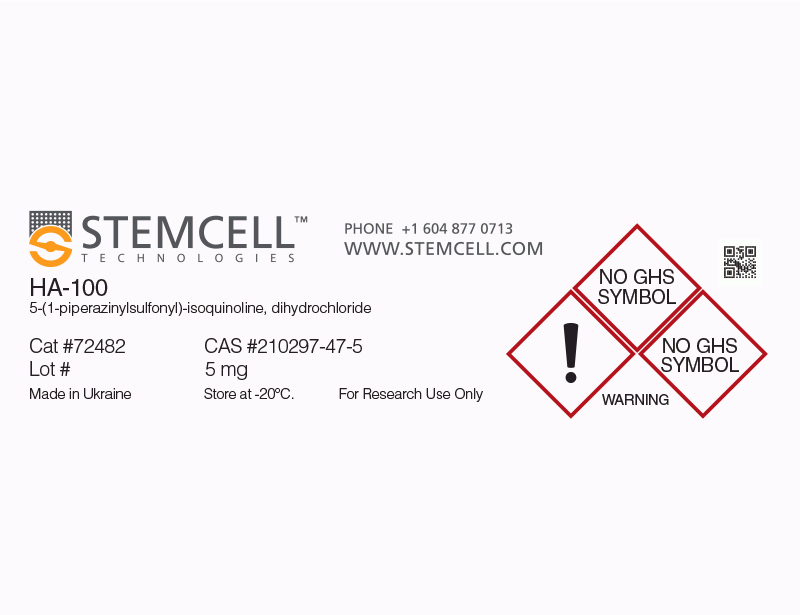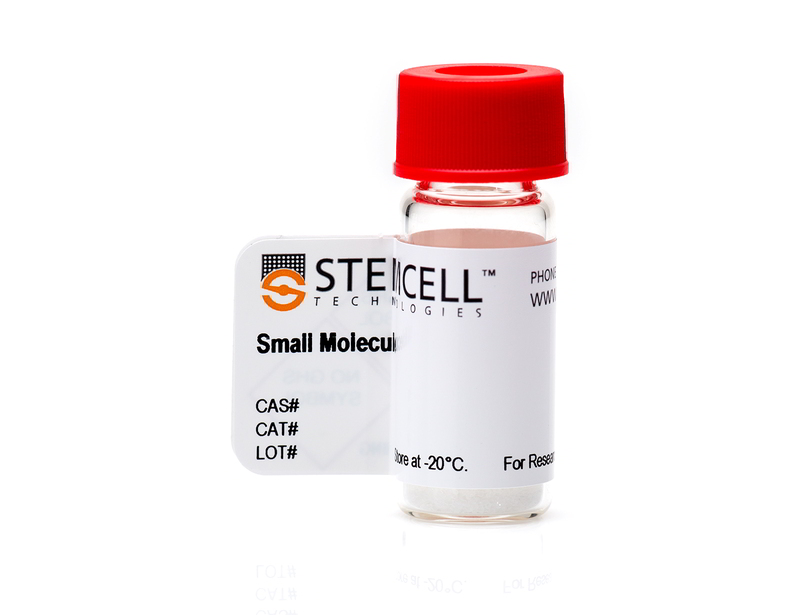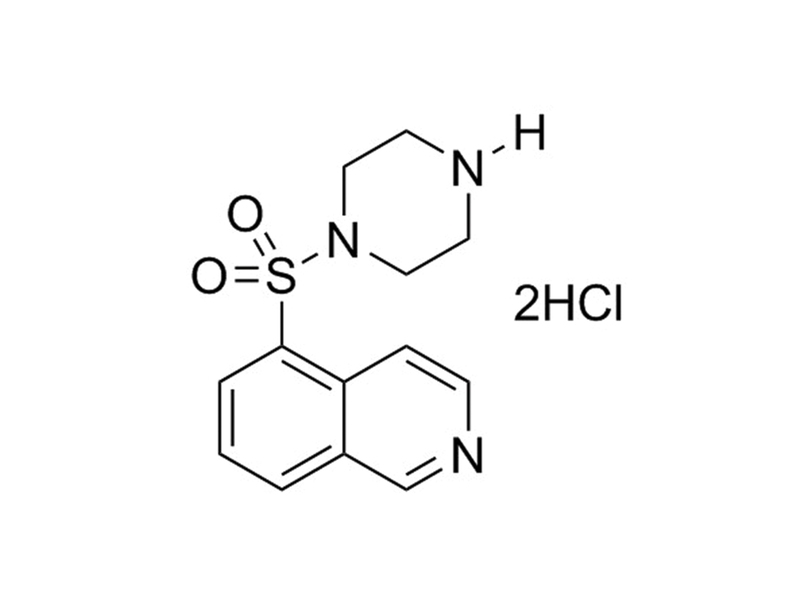概要
HA-100 is an isoquinoline compound with an added piperazinylsulfonyl group that acts as an inhibitor of protein kinases (PKs), including PKA, PKC, and PKG (IC₅₀ = 8, 12, and 4 µM, respectively) (Hagiwara et al.).
REPROGRAMMING
· Increases human fibroblast reprogramming efficiency with PD0325901, CHIR99021, A83-01 and hLIF (Yu et al.).
MAINTENANCE AND SELF-RENEWAL
· Improves single cell survival and supports high cloning efficiency in human pluripotent stem cell cultures (Chen et al.).
REPROGRAMMING
· Increases human fibroblast reprogramming efficiency with PD0325901, CHIR99021, A83-01 and hLIF (Yu et al.).
MAINTENANCE AND SELF-RENEWAL
· Improves single cell survival and supports high cloning efficiency in human pluripotent stem cell cultures (Chen et al.).
技术资料
| Document Type | 产品名称 | Catalog # | Lot # | 语言 |
|---|---|---|---|---|
| Product Information Sheet | HA-100 (Dihydrochloride) | 72482, 72484 | All | English |
| Safety Data Sheet | HA-100 (Dihydrochloride) | 72482, 72484 | All | English |
数据及文献
Publications (3)
Nature methods 2011 MAY
Chemically defined conditions for human iPSC derivation and culture.
Abstract
Abstract
We re-examine the individual components for human embryonic stem cell (ESC) and induced pluripotent stem cell (iPSC) culture and formulate a cell culture system in which all protein reagents for liquid media, attachment surfaces and splitting are chemically defined. A major improvement is the lack of a serum albumin component, as variations in either animal- or human-sourced albumin batches have previously plagued human ESC and iPSC culture with inconsistencies. Using this new medium (E8) and vitronectin-coated surfaces, we demonstrate improved derivation efficiencies of vector-free human iPSCs with an episomal approach. This simplified E8 medium should facilitate both the research use and clinical applications of human ESCs and iPSCs and their derivatives, and should be applicable to other reprogramming methods.
PloS one 2011 JAN
Efficient feeder-free episomal reprogramming with small molecules.
Abstract
Abstract
Genetic reprogramming of human somatic cells to induced pluripotent stem cells (iPSCs) could offer replenishable cell sources for transplantation therapies. To fulfill their promises, human iPSCs will ideally be free of exogenous DNA (footprint-free), and be derived and cultured in chemically defined media free of feeder cells. Currently, methods are available to enable efficient derivation of footprint-free human iPSCs. However, each of these methods has its limitations. We have previously derived footprint-free human iPSCs by employing episomal vectors for transgene delivery, but the process was inefficient and required feeder cells. Here, we have greatly improved the episomal reprogramming efficiency using a cocktail containing MEK inhibitor PD0325901, GSK3β inhibitor CHIR99021, TGF-β/Activin/Nodal receptor inhibitor A-83-01, ROCK inhibitor HA-100 and human leukemia inhibitory factor. Moreover, we have successfully established a feeder-free reprogramming condition using chemically defined medium with bFGF and N2B27 supplements and chemically defined human ESC medium mTeSR1 for the derivation of footprint-free human iPSCs. These improvements enabled the routine derivation of footprint-free human iPSCs from skin fibroblasts, adipose tissue-derived cells and cord blood cells. This technology will likely be valuable for the production of clinical-grade human iPSCs.
Molecular pharmacology 1987 JUL
Selective modulation of calcium-dependent myosin phosphorylation by novel protein kinase inhibitors, isoquinolinesulfonamide derivatives.
Abstract
Abstract
Ca2+-dependent myosin phosphorylation by Ca2+/calmodulin-dependent myosin light chain kinase (MLC-kinase) and protein kinase C were studied using selective inhibitors, isoquinolinesulfonamide derivatives. Both protein kinases were potently inhibited by 1-(8-chloro-5-isoquinolinesulfonyl)piperazine (HA-156) and its derivatives. Kinetic analysis indicated that HA-156 inhibited both enzymes competitively with respect to ATP, and Ki values of HA-156 for MLC-kinase and protein kinase C were 7.3 and 7.2 microM, respectively. To clarify molecular mechanisms of the isoquinolinesulfonamides to inhibit the Ca2+-dependent protein kinases, we examined the structure-activity relationships of HA-156 and its derivatives. The dechlorinated analogues, HA-100 and HA-142, markedly decreased the affinity for MLC-kinase, suggesting that the inhibitory effect of isoquinolinesulfonamide derivatives depends upon hydrophobicity of the compounds. There is a good correlation between MLC-kinase inhibition and hydrophobicity determined by reverse phase chromatography. In contrast, HA-140 and HA-142 showed weak inhibition of protein kinase C, suggesting that the electron density of the nitrogen in the isoquinoline ring of the compounds correlates with the potency to inhibit protein kinase C activity. These pairs of isoquinolinesulfonamides will aid in elucidating the biological roles of Ca2+-dependent myosin phosphorylation in intact cells. HA-156 and HA-140 inhibited myosin light chain phosphorylation in platelets exposed to collagen, whereas HA-142 and HA-100 did not, significantly. These isoquinolinesulfonamide derivatives should prove to be useful tools for distinguishing between the biological functions of Ca2+-activated, phospholipid-dependent, and Ca2+/calmodulin-dependent myosin light chain phosphorylation, in vivo.

 网站首页
网站首页





